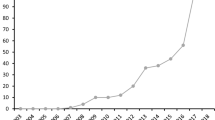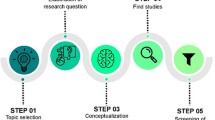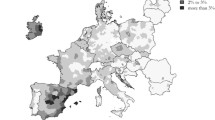Abstract
We examine the effect of air pollution on innovation activity by studying city-level patenting activities and air pollution index (API) in China. We use a novel quasi-natural experiment of China’s Huai River policy, which provides subsidy for winter heating to cities north of the Huai River but not to cities to the south, to estimate the impact of air pollution on innovation performance. Based on spatial regression discontinuity design, we find that API is 0.145 higher in the north and the number of patents per city is 25.5% lower in the north. Further analysis shows that increases in API are associated with significant reduction in the number of patents per city, suggesting that air pollution significantly impedes innovation activities.



Similar content being viewed by others
Data availability statement
Data used in this study are obtained from the following: Air Pollution Index (API) is from CSMAR, a public database with license fees. Names, city name, latitude and longitude data of individual inventors and patent data are sourced from Harvard Business School (HBS) patent and inventor database (a free public dataset) and United States Patent and Trademark Office (USPTO) data (a public dataset with license fees), and National Bureau of Economic Research (NBER) utility patent database (a free public dataset). Regional controls are sourced from China City Statistical Yearbook, a free public dataset. Temperature data is freely downloaded from the National Meteorological Information Center of China.
Notes
See World Bank. (2005) China Heat Reform and Building Energy Efficiency Project. Tech. report, World Bank Group, Washington, DC. http://documents.worldbank.org/curated/en/458551468770148424/China-Heat-Reform-and-Building-Energy-Efficiency-Project.
Although Wang et al. (2021a, b) and our paper both examine air pollution and innovation, our paper differs significantly from that of Wang et al. (2021a, b) in the following three ways: (1) source and quality of patent data; (2) identification strategy; and (3) scope of inventors. First, we use patent data from the Harvard Business School (HBS) patent and inventor database, which is based on all patents (not limited to the US firms) filed with the United States Patent and Trademark Office (USPTO). Patent data of Wang et al. (2021a, b) come from firm-level patents in the Chinese State Intellectual Property Office (CSIPO) covered in the China Stock Market & Accounting Research (CSMAR) database and supplemented by the WIND database. Following Ma et al. (2009) and Wu and Mathews (2012), we focus on patents filed with the USPTO but not to the CSIPO because U.S. patents are usually regarded as having better technological capability and reliability. Second, we differ from Wang et al. (2021a, b) in the identification strategy. We adopt a quasi-natural experiment using China’s Huai River Policy and perform spatial discontinuity regression. They use local thermal inversions as the exogenous instrumental variable and then perform two-stage least squares regression analysis. Based on our spatial RDD results, we interpret the economic effect of air pollution on innovation as about 25.5% lower in the north, which has more severe air pollution. Yet, the economic effect of air pollution is not clearly stated in Wang et al. (2021a, b). Finally, our paper differs from Wang et al. (2021a, b) in terms of the scope of research target. Wang et al. (2021a, b) include only listed firm innovation, but we include innovations from a much greater range of all institutes: listed firms, private firms, colleges, and research institutes. Our paper thus has broader implications for air pollution prevention because it shows that not only inventors at listed firms but many other inventors are suffering from the effects of air pollution.
Available at: https://dataverse.harvard.edu/dataverse/patent. See Li et al. (2014) for a detailed description.
The inventor data generated by Li et al. (2014) corrects inconsistent reports of individual inventors among different patent documents. They also distinguish different inventors who have the same names. The way they identify inventors is with a disambiguation algorithm, which considers all pairs of inventor-patent cases and then determines whether any two paired inventor’s names are subject to the same inventor career.
We also try to examine design patent data from European Patent Office (EPO) Worldwide Patent Statistical Database (PATSTAT), which provides patent information from many patent and trademark offices including U.S., European, Japan, Korea and so on. We find that Chinese inventors apply very few design patents to USPTO. Yet, we find that less than 5% of US patents applied by Chinese inventors are design patents, the aggregate amount of design patents is fewer than 100 every year. In such background, we cannot have meaningful analysis on design patents.
One should notice that we identify the location of an inventor rather than the location of a patent applicant, since they could be different when the inventor is hired by the firm that files the patent with the USPTO. For example, if inventor X (who lives in Hangzhou) is hired by company A (located in Shanghai), we identify the location of inventor X as Hangzhou.
Data is available from here: http://data.cma.cn/en/?r=data/detail&dataCode=SURF_CLI_CHN_MUL_YER_CES.
Similar to our previous section, we also perform diagnostic tests for the validity of the RDD design for our robustness checks and additional analyses. Our test results show that the conditions for applying the RDD are satisfied. To save space, we do not report these test results here, but they are available upon request.
References
Almond D, Chen Y, Greenstone M, Li H (2009) Winter heating or clean air? Unintended impacts of China’s Huai River Policy. Am Econ Rev 99(2):184–190
Baylis P, Obradovich N, Kryvasheyeu Y, Chen H, Coviello L, Moro E, Cebrian M, Fowler JH (2018) Weather impacts expressed sentiment. PLoS ONE 13(4):1–11
Belenzon S, Berkovitz T (2010) Innovation in business groups. Manag Sci 56(3):519–535
Bovenberg AL, De Mooij RA (1997) Environmental tax reform and endogenous growth. J Public Econ 63(2):207–237
Bowe B, **e Y, Li T, Yan Y, **an H, Al-Aly Z (2017) Associations of ambient coarse particulate matter, nitrogen dioxide, and carbon monoxide with the risk of kidney disease: a cohort study. Lancet Planet Health 1(7):e267–e276
Bowe B, **e Y, Li T, Yan Y, **an H, Al-Aly Z (2018) The 2016 global and national burden of diabetes mellitus attributable to PM 25 air pollution. Lancet Planet Health 2(7):e301–e312
Bradley D, Kim I, Tian X (2017) Do unions affect innovation? Manag Sci 63(7):2251–2271
Brown JR, Fazzari SM, Petersen BC (2009) Financing innovation and growth: cash flow, external equity, and the 1990s R&D boom. J Finance 64(1):151–185
Brunekreef B, Holgate ST (2002) Air pollution and health. Lancet 360(9341):1233–1242
Chen X (2017) Effect of particulate air pollution on coronary heart disease in China: Evidence from threshold GAM and Bayesian hierarchical model. Phys Chem Earth Parts a/b/c 101:35–42
Chen S, Bloom DE (2019) The macroeconomic burden of noncommunicable diseases associated with air pollution in China. PLoS ONE 14(4):1–14
Chen SS, Chen YS, Liang WL, Wang Y (2020) Public R&D spending and cross-sectional stock returns. Res Policy 49(1):103887
Chen Y, Ebenstein A, Greenstone M, Li H (2013) Evidence on the impact of sustained exposure to air pollution on life expectancy from China’s Huai River policy. Proc Natl Acad Sci 110(32):12936–12941
Chen SS, Huang CW, Hwang CY, Wang Y (2022) Voluntary disclosure and corporate innovation. Rev Quant Finance Account 58(3):1081–1115
Connolly M (2013) Some like it mild and not too wet: the influence of weather on subjective well-being. J Happiness Stud 14(2):457–473
Dai L, Kloog I, Coull BA, Sparrow D, Spiro A, Vokonas PS, Schwartz JD (2016) Cognitive function and short-term exposure to residential air temperature: a repeated measures study based on spatiotemporal estimates of temperature. Environ Res 150:446–451
Ebenstein A, Fan M, Greenstone M, He G, Zhou M (2017) New evidence on the impact of sustained exposure to air pollution on life expectancy from China’s Huai River Policy. Proc Natl Acad Sci 114(39):10384–10389
Fang VW, Tian X, Tice S (2014) Does stock liquidity enhance or impede firm innovation? J Finance 69(5):2085–2125
Fassio C, Montobbio F, Venturini A (2019) Skilled migration and innovation in European industries. Res Policy 48(3):706–718
Freeman R, Liang W, Song R, Timmins C (2019) “Willingness to pay for clean air in” China. J Environ Econ Manag 94:188–216
Gao H, Hsu PH, Li K, Zhang J (2020) The real effect of smoking bans: evidence from corporate innovation. J Financ Quant Anal 55(2):387–427
Gradus R, Smulders S (1993) The trade-off between environmental care and long-term growth-pollution in three prototype growth models. J Econ 58(1):25–51
Graff ZJ, Hsiang SM, Neidell M (2018) Temperature and human capital in the short and long run. J Assoc Environ Resour Econ 5(1):77–105
He J, Tian X (2013) The dark side of analyst coverage: the case of innovation. J Financ Econ 109(3):856–878
Hirshleifer D, Low A, Teoh SH (2012) Are overconfident CEOs better innovators? J Finance 67(4):1457–1498
Huang J, Xu N, Yu H (2020) Pollution and performance: Do investors make worse trades on Hazy Days? Manag Sci. https://doi.org/10.1287/mnsc.2019.3402
Ito K, Zhang S (2020) Willingness to pay for clean air: evidence from air purifier markets in China. J Polit Econ 128(5):1627–1672
Kim KH, Oler DK, Sanchez JM (2021) Examining the stock performance of acquirers where the acquirer or target hold patents. Rev Quant Finance Account 56(1):185–217
Kågeson P (2012) Growth versus the environment: Is there a trade-off? Springer, Berlin
Li GC, Lai R, D’Amour A, Doolin DM, Sun Y, Torvik VI, Yu AZ, Lee F (2014) Disambiguation and co-authorship networks of the U.S. patent inventor database (1975–2010). Res Policy 43(6):941–955
Li JJ, Massa M, Zhang H, Zhang J (2021) Air pollution, behavioral bias, and the disposition effect in China. J Financ Econ 142(2):641–673
Lin H, Liu T, **ao J, Zeng W, Guo L, Li X, Xu Y et al (2017) Hourly peak PM2.5 concentration associated with increased cardiovascular mortality in Guangzhou, China. J Exposure Sci Environ Epidemiol 27(3):333–338
Lin H, Liu T, **ao J, Zeng W, Li X, Guo L, Zhang Y et al (2016) Mortality burden of ambient fine particulate air pollution in six Chinese cities: results from the Pearl River Delta study. Environ Int 96:91–97
Ma Z, Lee Y, Chen CFP (2009) Booming or emerging? China’s technological capability and international collaboration in patent activities. Technol Forecast Soc Change 76(6):787–796
Marinova D, McAleer M (2006) Anti-pollution technology strengths indicators: international rankings. Environ Model Softw 21(9):1257–1263
Matus K, Nam K-M, Selin NE, Lamsal LN, Reilly JM, Paltsev S (2012) Health damages from air pollution in China. Glob Environ Change 22(1):55–66
Noelke C, McGovern M, Corsi DJ, Jimenez MP, Stern A, Wing IS, Berkman L (2016) Increasing ambient temperature reduces emotional well-being. Environ Res 151:124–129
Pope CA, Dockery DW (2013) Air pollution and life expectancy in China and beyond. Proc Natl Acad Sci 110(32):12861–12862
Pope CA, Ezzati M, Dockery DW (2009) Fine-particulate air pollution and life expectancy in the United States. N Engl J Med 360(4):376–386
Popp D (2006) International innovation and diffusion of air pollution control technologies: The effects of NOX and SO2 regulation in the US, Japan, and Germany. J Environ Econ Manag 51(1):46–71
Tanaka S (2015) Environmental regulations on air pollution in China and their impact on infant mortality. J Health Econ 42:90–103
Wang X, Wu G, **ang Z, Zhang J (2021b) Air pollution and media slant: evidence from Chinese corporate news. Emerg Mark Finance Trade. https://doi.org/10.2139/ssrn.3850535
Wang L, **ng F, Yu Y, Dai Y (2021a) Does severe air pollution affect firm innovation: evidence from China. Appl Econ Lett 28(7):551–558
Wu CY, Mathews JA (2012) Knowledge flows in the solar photovoltaic industry: insights from patenting by Taiwan, Korea, and China. Res Policy 41(3):524–540
Xue S, Zhang B, Zhao X (2019) Brain drain: the impact of air pollution on firm performance. Available at SSRN: https://ssrn.com/abstract=3490344
Zhou M, He G, Liu Y, Yin P, Li Y, Kan H, Fan M, Xue A, Fan M (2015) The associations between ambient air pollution and adult respiratory mortality in 32 major Chinese cities, 2006–2010. Environ Res 137:278–286
Acknowledgements
We thank Konan Chan, Ching-Hung Chang, Sheng-Syan Chen, Hung-Kun Chen, I-Ju Chen, Yan-Shing Chen, Chia-Wei Huang, Kenneth Huang, Po-Hsuan Hsu, Woan-lih Liang, Cheng-Few Lee (the editor), Carl Shen, and two anonymous referees for their valuable comments. This work was financially supported by the Center for Research in Econometric Theory and Applications (Grant no. 108L900202) from the Featured Areas Research Center Program within the framework of the Higher Education Sprout Project by the Ministry of Education (MOE) in Taiwan. Yanzhi Wang is also grateful for fundings from by National Science and Technology Council (formerly the Ministry of Science and Technology) in Taiwan (NSTC 107-3017-F-002-004 and NSTC 108-2410-H-002-085-MY2). Zhaohua Li recognizes financial support from Lincoln University. Zhuo Qiao gratefully acknowledges financial support from University of Macau (research Grant No.: MYRG2019-00070-FBA). The authors thanks Chutarat Noosuwan for research assistance and Michael Turton for editorial assistance.
Author information
Authors and Affiliations
Corresponding author
Additional information
Publisher's Note
Springer Nature remains neutral with regard to jurisdictional claims in published maps and institutional affiliations.
Rights and permissions
Springer Nature or its licensor holds exclusive rights to this article under a publishing agreement with the author(s) or other rightsholder(s); author self-archiving of the accepted manuscript version of this article is solely governed by the terms of such publishing agreement and applicable law.
About this article
Cite this article
Qiao, Z., Li, Z. & Wang, Y. Air pollution and innovation-evidence from quasi-natural experiment of China’s Huai River policy. Rev Quant Finan Acc 60, 425–443 (2023). https://doi.org/10.1007/s11156-022-01097-1
Accepted:
Published:
Issue Date:
DOI: https://doi.org/10.1007/s11156-022-01097-1




